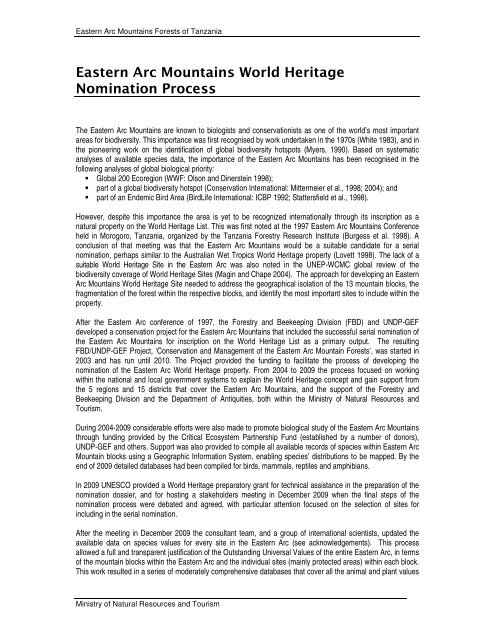eastern arc mountains forests of tanzania - Campaign for the ...
eastern arc mountains forests of tanzania - Campaign for the ...
eastern arc mountains forests of tanzania - Campaign for the ...
You also want an ePaper? Increase the reach of your titles
YUMPU automatically turns print PDFs into web optimized ePapers that Google loves.
Eastern Arc Mountains Forests <strong>of</strong> Tanzania<br />
Eastern Arc Mountains World Heritage<br />
Nomination Process<br />
The Eastern Arc Mountains are known to biologists and conservationists as one <strong>of</strong> <strong>the</strong> world’s most important<br />
areas <strong>for</strong> biodiversity. This importance was first recognised by work undertaken in <strong>the</strong> 1970s (White 1983), and in<br />
<strong>the</strong> pioneering work on <strong>the</strong> identification <strong>of</strong> global biodiversity hotspots (Myers, 1990). Based on systematic<br />
analyses <strong>of</strong> available species data, <strong>the</strong> importance <strong>of</strong> <strong>the</strong> Eastern Arc Mountains has been recognised in <strong>the</strong><br />
following analyses <strong>of</strong> global biological priority:<br />
� Global 200 Ecoregion (WWF: Olson and Dinerstein 1998);<br />
� part <strong>of</strong> a global biodiversity hotspot (Conservation International: Mittermeier et al., 1998; 2004); and<br />
� part <strong>of</strong> an Endemic Bird Area (BirdLife International: ICBP 1992; Stattersfield et al., 1998).<br />
However, despite this importance <strong>the</strong> area is yet to be recognized internationally through its inscription as a<br />
natural property on <strong>the</strong> World Heritage List. This was first noted at <strong>the</strong> 1997 Eastern Arc Mountains Conference<br />
held in Morogoro, Tanzania, organized by <strong>the</strong> Tanzania Forestry Rese<strong>arc</strong>h Institute (Burgess et al. 1998). A<br />
conclusion <strong>of</strong> that meeting was that <strong>the</strong> Eastern Arc Mountains would be a suitable candidate <strong>for</strong> a serial<br />
nomination, perhaps similar to <strong>the</strong> Australian Wet Tropics World Heritage property (Lovett 1998). The lack <strong>of</strong> a<br />
suitable World Heritage Site in <strong>the</strong> Eastern Arc was also noted in <strong>the</strong> UNEP-WCMC global review <strong>of</strong> <strong>the</strong><br />
biodiversity coverage <strong>of</strong> World Heritage Sites (Magin and Chape 2004). The approach <strong>for</strong> developing an Eastern<br />
Arc Mountains World Heritage Site needed to address <strong>the</strong> geographical isolation <strong>of</strong> <strong>the</strong> 13 mountain blocks, <strong>the</strong><br />
fragmentation <strong>of</strong> <strong>the</strong> <strong>for</strong>est within <strong>the</strong> respective blocks, and identify <strong>the</strong> most important sites to include within <strong>the</strong><br />
property.<br />
After <strong>the</strong> Eastern Arc conference <strong>of</strong> 1997, <strong>the</strong> Forestry and Beekeeping Division (FBD) and UNDP-GEF<br />
developed a conservation project <strong>for</strong> <strong>the</strong> Eastern Arc Mountains that included <strong>the</strong> successful serial nomination <strong>of</strong><br />
<strong>the</strong> Eastern Arc Mountains <strong>for</strong> inscription on <strong>the</strong> World Heritage List as a primary output. The resulting<br />
FBD/UNDP-GEF Project, ‘Conservation and Management <strong>of</strong> <strong>the</strong> Eastern Arc Mountain Forests’, was started in<br />
2003 and has run until 2010. The Project provided <strong>the</strong> funding to facilitate <strong>the</strong> process <strong>of</strong> developing <strong>the</strong><br />
nomination <strong>of</strong> <strong>the</strong> Eastern Arc World Heritage property. From 2004 to 2009 <strong>the</strong> process focused on working<br />
within <strong>the</strong> national and local government systems to explain <strong>the</strong> World Heritage concept and gain support from<br />
<strong>the</strong> 5 regions and 15 districts that cover <strong>the</strong> Eastern Arc Mountains, and <strong>the</strong> support <strong>of</strong> <strong>the</strong> Forestry and<br />
Beekeeping Division and <strong>the</strong> Department <strong>of</strong> Antiquities, both within <strong>the</strong> Ministry <strong>of</strong> Natural Resources and<br />
Tourism.<br />
During 2004-2009 considerable ef<strong>for</strong>ts were also made to promote biological study <strong>of</strong> <strong>the</strong> Eastern Arc Mountains<br />
through funding provided by <strong>the</strong> Critical Ecosystem Partnership Fund (established by a number <strong>of</strong> donors),<br />
UNDP-GEF and o<strong>the</strong>rs. Support was also provided to compile all available records <strong>of</strong> species within Eastern Arc<br />
Mountain blocks using a Geographic In<strong>for</strong>mation System, enabling species’ distributions to be mapped. By <strong>the</strong><br />
end <strong>of</strong> 2009 detailed databases had been compiled <strong>for</strong> birds, mammals, reptiles and amphibians.<br />
In 2009 UNESCO provided a World Heritage preparatory grant <strong>for</strong> technical assistance in <strong>the</strong> preparation <strong>of</strong> <strong>the</strong><br />
nomination dossier, and <strong>for</strong> hosting a stakeholders meeting in December 2009 when <strong>the</strong> final steps <strong>of</strong> <strong>the</strong><br />
nomination process were debated and agreed, with particular attention focused on <strong>the</strong> selection <strong>of</strong> sites <strong>for</strong><br />
including in <strong>the</strong> serial nomination.<br />
After <strong>the</strong> meeting in December 2009 <strong>the</strong> consultant team, and a group <strong>of</strong> international scientists, updated <strong>the</strong><br />
available data on species values <strong>for</strong> every site in <strong>the</strong> Eastern Arc (see acknowledgements). This process<br />
allowed a full and transparent justification <strong>of</strong> <strong>the</strong> Outstanding Universal Values <strong>of</strong> <strong>the</strong> entire Eastern Arc, in terms<br />
<strong>of</strong> <strong>the</strong> mountain blocks within <strong>the</strong> Eastern Arc and <strong>the</strong> individual sites (mainly protected areas) within each block.<br />
This work resulted in a series <strong>of</strong> moderately comprehensive databases that cover all <strong>the</strong> animal and plant values<br />
Ministry <strong>of</strong> Natural Resources and Tourism


